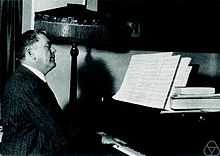Derrick Norman Lehmer
| Derrick Norman Lehmer | |
|---|---|
 | |
| Born |
July 27, 1867 Somerset, Indiana, United States |
| Died |
September 8, 1938 Berkeley, California, United States |
| Education |
University of Nebraska University of Chicago |
| Occupation | Mathematician |
| Spouse(s) | Clara Eunice Mitchell |
| Children | Eunice (b. 1903), Helen (b. 1904), Derrick Henry (b. 1905), Stephen (b. 1906), Alice (b. 1911) |
| Parent(s) | Derrick Fernstück Lehmer; Isabel Smith Peery |
Derrick Norman Lehmer (27 July 1867 – 8 September 1938) was an American mathematician and number theorist.
He was educated at the University of Nebraska, obtaining a bachelor's degree in 1893 and master's in 1896. Lehmer was awarded his Ph.D. from the University of Chicago in 1900 for a thesis Asymptotic Evaluation of Certain Totient-Sums under the supervision of E. H. Moore. He was appointed instructor in mathematics at the University of California at Berkeley in 1900 and married Clara Eunice Mitchell on 12 July 1900 in Decatur, Illinois. He was promoted to professor at Berkeley in 1918 and continued to teach there until retiring in 1937.
In 1903, he presented a factorization of Jevons' number (8,616,460,799) at the San Francisco Section of the American Mathematical Society, December 19, 1903.[1][2]
He published tables of prime numbers and prime factorizations, reaching 10,017,000 by 1909.[3] He developed a variety of mechanical and electro-mechanical factoring and computational devices, such as the Lehmer sieve, built with his son Derrick Henry Lehmer.
Selected works
- "Arithmetical theory of certain Hurwitzian continued fractions". Proc Natl Acad Sci U S A 4 (8): 214–218. 1918. doi:10.1073/pnas.4.8.214. PMC 1091449.
- "On Jacobi's extension of the continued fraction algorithm". Proc Natl Acad Sci U S A 4 (12): 360–364. 1918. doi:10.1073/pnas.4.12.360. PMC 1091496.
- "On a new method of factorization". Proc Natl Acad Sci U S A 11 (1): 97–98. 1925. doi:10.1073/pnas.11.1.97. PMC 1085844.
- "A theorem on factorization". Bull. Amer. Math. Soc. 33 (1): 35–36. 1927. doi:10.1090/s0002-9904-1927-04299-9. MR 1561316.
- "Inverse ternary continued fractions". Bull. Amer. Math. Soc. 37 (8): 565–569. 1931. doi:10.1090/s0002-9904-1931-05206-x. MR 1562198.
- "On the enumeration of magic cubes". Bull. Amer. Math. Soc. 40 (12): 833–837. 1934. doi:10.1090/s0002-9904-1934-05976-7. MR 1562983.
Notes
- ↑ Lehmer, D.N., "A Theorem in the Theory of Numbers", read before the San Francisco Section of the American Mathematical Society, December 19, 1903.
- ↑ William Stanley Jevons had written in his Principles of Science, p. 123, "Can the reader say what two numbers multiplied together will produce the number 8616460799 ? I think it unlikely that anyone but myself will ever know." Lehmer added "I think that the number has been resolved before, but I do not know by whom."
- ↑ Lehmer, D. N., Factor table for the first ten millions containing the smallest factor of every number not divisible by 2, 3, 5, or 7 between the limits 0 and 10017000, Carnegie institution of Washington. Publication no. 105, 1909.
References
- Albert H. Beiler, Recreations in the theory of numbers, Dover, 1964; chap.XX
External links
- Works by Derrick Norman Lehmer at Project Gutenberg
- Works by or about Derrick Norman Lehmer at Internet Archive
- O'Connor, John J.; Robertson, Edmund F., "Derrick Norman Lehmer", MacTutor History of Mathematics archive, University of St Andrews.
- Derrick Norman Lehmer at the Mathematics Genealogy Project
|